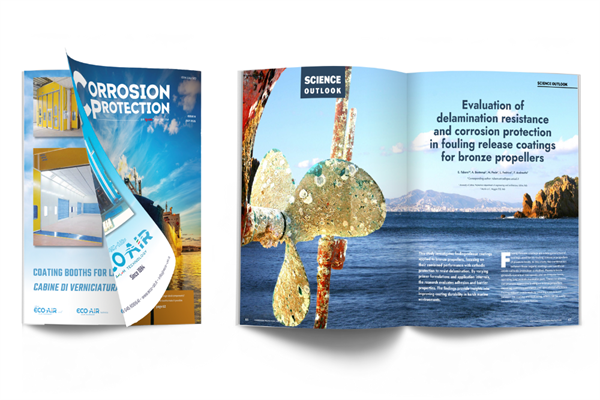
Read the latest issue of the magazine dedicated to corrosion prediction, prevention, protection and mitigation – Special edition on the marine sector!
Can the sea be considered infrastructure?
While offshore platforms and cargo and merchant ships have long been a part of many coastal countries’ seascapes, offshore wind farms are a more recent addition, as young as wind technology itself. Yet, the sum of these three industries colonising the sea highlights how much it has been, and still is, a fundamental infrastructure for development. From a backdrop, the sea has become a multifunctional operating field.
At the same time, the marine environment presents numerous challenges for structures operating within it.
Marine exposure is extremely aggressive: salt spray and UV rays in splash zone areas can cause corrosion thicknesses of up to 500 µm/year, compared with 25-50 µm in C3 onshore environments. There are several critical areas to consider, including the atmospheric zone, which is subject to saline microclimates and intense UV rays; the splash/tidal zone, which is subject to wet/dry cycles and abrasion; and the submerged zone.
In offshore environments, corrosion protection begins with design: the shape of structures, the accessibility of components, and the treatment of welds directly affect the durability of coatings. Details that may seem minor, such as rounded edges, well-finished joints, or access routes, are essential to ensure uniform coverage and prevent the accumulation of water or salt.
Engineering choices regarding materials are also crucial, from duplex or super duplex stainless steels to enhance pitting and stress corrosion resistance to reinforced polymers or FRP in specific components, such as wind turbine blades.
Finally, corrosion prevention depends on a comprehensive plan, which usually includes visual inspections and NDT (ultrasound, eddy current) via ROVs or drones to detect early corrosion; electrochemical monitoring and SHM sensors to check potentials, thicknesses, micro cracks, and microbial activity; and predictive analyses using AI to optimise maintenance times and costs based on environmental and structural data.
The aim is to combine preventive engineering, advanced and multi-layer coatings, adequate cathodic protection, and continuous monitoring, adopting a life-cycle approach based on the idea that preserving structural integrity reduces downtime and costs while protecting the ecosystem balance and promoting sustainability.
The fight against corrosion in the marine industry cannot, therefore, be reduced to a single system or technology. A combined strategy is needed, from design to predictive maintenance.
This Corrosion Protection issue includes a focus on the marine sector, one of the sectors where companies that produce corrosion protection systems concentrate most of their R&D activities, with research aimed at achieving maximum anti-corrosion performance for components. The training of offshore facility operators is equally crucial, to the extent that a course on corrosion has been recently launched for seafarers.
READ THE MAGAZINE!